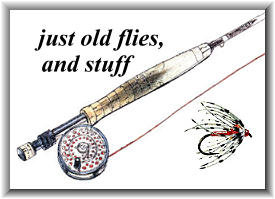The Iron Blue Dun is a fly I remember well
from the early '60s, mostly as a dry fly
then. I've learned that it imitates the
Paraleptophlebia group of mayflies, which
means as much to me now as it would have then,
next to nothing. I think that these days this
mayfly must be imitated with an Adams or
parachute Adams, as I don't see Iron Blue
Dun patterns around shops like I do Hendricksons,
Sulphurs, PMDs, etc. Here's what J.Edson Leonard
had to say about the Iron Blue Dun in 1950:
"There are perhaps as many variations of
the Iron Blue as there are iron blues in
your favorite stream. Fly-makers make this
fly in shades from light brown to near black.
Actually, few imitations even remotely resemble
the natural insect. One can purchase Iron Blues
form several fly-dressers, and be equipped with
enough varieties to meet most fishing conditions.
The Iron Blue is as necessary to the fly-box as
tobacco is to your pipe; therefore, its colors
should be known."
He goes on to say that male dun emerges in
late May, with a grayish-olive body and dark
grayish-blue wings. The female is similar,
with a purplish-brown body. It's a dark fly.
Leonard recommends the dark gray-blue feathers
from the Coot for the wings, but most dressings
just have the typical gray mallard wings. Halford
had four different dressings for this fly in his
book Floating Flies, J. Edson Leonard
eleven, not counting spinners, Bergman one dry fly,
and Mary Orvis Marbury recommends carrying imitations
in several different shades. To make matters worse,
the fly has as many names as it has dressings, i.e.
Iron-blue Drake, Little Dark Blue, Little Dark Dun,
Dark Watchet, Dark Whirling Blue Dun, Pearl Drake,
and Iron Blue Quill. The spinner is known as the
Jenny Spinner.
This fly is given great importance by
all the old authors, yet you don't hear
much about it or the Paraleptophlebia
Adoptiva, at least in the areas of the
Midwest, West, and East that I fish. I
do hear of the Blue Quill now and again,
which is listed as a member of Paraleptophlebia
on the trout-stream.com web site, but
here in Ohio that fly appears in April,
and I'm not convinced that it's the same.
The Blue Quill IS shown as Paraleptophlebia
Adoptiva in Brian Flechsig's book Fly
Fisher's Guide to the Mad River, but
I've fished that hatch in early April, and
those flies don't look like Iron Blue Duns
to me. There's quite some mystery concerning
the Iron Blue Dun and its disappearance from
the collective fly fishing consciousness.
Perhaps it's simply a question of the fly
being renamed the Blue Quill, Slate Drake,
or something else these days. It's interesting
to me that J. Edson Leonard shows a Blue Quill
hatch occurring in early April, and an Iron
Blue Dun hatch occurring in late May, two
different hatches. I suppose that this all
varies a great deal by stream, and by local
terminology.
So we have maybe two different hatches,
with flies that have 20 different names,
and more dressings than we can count. So
do what I do and look at the bugs on your
local stream and tie something up that
looks like that. The Iron Blue Dun has
wet fly versions as well, and a particularly
nice version was sent to me by Alice Conba
of Ireland. I have tied a rendition of her
fly, and also tied the dry fly I remember
from my youth. Here are the recipes:
Iron Blue Dun Dry Fly (shown at the top)
Tag: Red
Tail: Furnace or dark brown hackle or coq de leon.
Body: Blue-gray fur dubbing.
Wings: Dark slate.
Hackle: Furnace.

Alice Conba's Iron Blue Dun Wet Fly
Tag: Red.
Tail: Blue dun.
Body: Dark gray dubbing.
Wings: Mallard.
Hackle: Blue dun.
Credits: Trout by Ray Bergman;
Flies by J. Edson Leonard; Favorite
Flies and Their Histories by Mary Orvis Marbury;
Fly Fisher's Guide to the Mad River by
Brian Flechsig; http://www.trout-streams.com ~ Eric Austin
|


